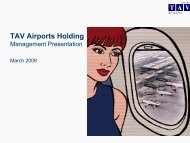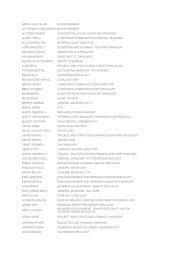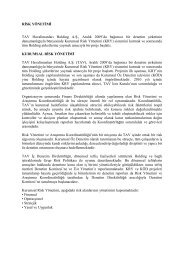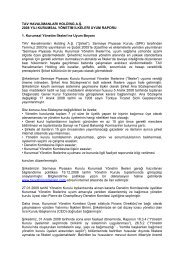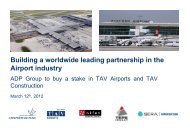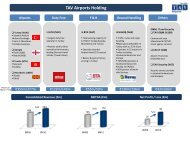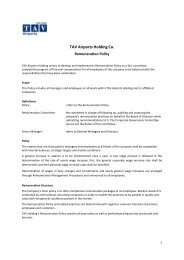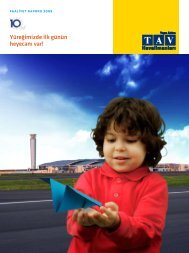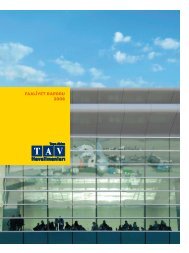TAV IT
TAV IT
TAV IT
Create successful ePaper yourself
Turn your PDF publications into a flip-book with our unique Google optimized e-Paper software.
<strong>TAV</strong> AIRPORTS HOLDING AND <strong>IT</strong>S SUBSIDIARIES<br />
NOTES TO THE CONSOLIDATED FINANCIAL STATEMENTS<br />
AS AT AND FOR THE YEAR ENDED 31 DECEMBER 2008<br />
(Amounts expressed in Euro unless otherwise stated)<br />
The consideration receivable for the construction services delivered includes direct costs of construction and borrowing and other<br />
similar costs that are directly related to the construction of the airport and related infrastructure.<br />
Amortisation of the airport operation right is calculated on a straight line basis. The calculated amortisation for the year ended 31<br />
December 2008 amounts to EUR 6,733,771 for <strong>TAV</strong> Esenboğa, EUR 9,791,578 for <strong>TAV</strong> İzmir and EUR 2,573,183 for <strong>TAV</strong> Tbilisi. For<br />
<strong>TAV</strong> Tunisie no amortisation has been calculated as the construction of the airport is still in progress. The estimated useful life of<br />
an intangible asset in a service concession arrangement is the period from when it is available for use to the end of the concession<br />
period.<br />
ii) Financial assets<br />
The Group recognizes the guaranteed amount due from DHMİ as financial asset which is determined by the agreements with <strong>TAV</strong><br />
Esenboğa and <strong>TAV</strong> İzmir. Financial assets are initially recognised at fair value. Fair value of financial assets are estimated as the<br />
present value of all future cash receipts discounted using the prevailing market rate of instrument.<br />
As at 31 December 2008, the short and long term guaranteed passenger fee receivable from DHMİ equals to EUR 179,431,222 (31<br />
December 2007: EUR 203,907,254).<br />
iii) Accounting for operations contract (<strong>TAV</strong> İstanbul)<br />
The costs associated with the operations contract primarily include rental payments and payments made to enhance and improve<br />
ADAT. <strong>TAV</strong> İstanbul prepaid certain rental amounts and the prepayment is deferred as prepaid rent and is recognised over the life of<br />
the prepayment period. The expenditures <strong>TAV</strong> İstanbul incurs to enhance and improve the domestic terminal are recorded as prepaid<br />
development expenditures and are being amortised over the life of the associated contract. Any other costs associated with regular<br />
maintenance are expensed in the period in which they are incurred.<br />
Under IFRIC 12 “Service Concession Arrangements” an operator recognises an intangible asset or financial asset received as<br />
consideration for providing construction or upgrade services or other items. In <strong>TAV</strong> İstanbul there is no construction nor significant<br />
upgrade service provided and the contract is in operating phase. Therefore, no intangible asset or financial asset is recognised in<br />
<strong>TAV</strong> İstanbul’s financial statements and the revenue and costs relating to the operation services are recognised in accordance with<br />
IAS 18 as required by IFRIC 12 (see note 43).<br />
Amortisation of the airport operation right is calculated on a straight line basis over the BOT periods of each project from the date<br />
of commencement of physical construction of the terminal.<br />
g) Leased assets<br />
Leases in terms of which the Group assumes substantially all the risks and rewards of ownership are classified as finance leases.<br />
Upon initial recognition the leased asset is measured at an amount equal to the lower of its fair value and the present value of the<br />
minimum lease payments. Subsequent to initial recognition, the asset is accounted for in accordance with the accounting policy<br />
applicable to that asset.<br />
Other leases are operating leases and the leased assets are not recognised on the Group’s balance sheet.<br />
h) Inventories<br />
Inventories are measured at the lower of cost and net realisable value. The cost of inventories is based on the first-in first-out<br />
principle, and includes expenditure incurred in acquiring the inventories, production or conversion costs and other costs incurred in<br />
bringing them to their existing location and condition.<br />
Net realisable value is the estimated selling price in the ordinary course of business, less the estimated costs of completion and<br />
selling expenses.



